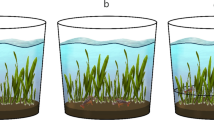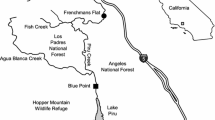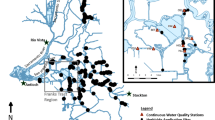Abstract
Management actions to control invasive aquatic species can have significant ecosystem-scale effects. We evaluated the water chemistry and nutrient effects of mechanical shredding to control water hyacinth (Eichhornia crassipes) in an agricultural slough and a tidal wetland on the Sacramento-San Joaquin River Delta, California. Shredding was conducted with two types of shredder boats in fall of 2003 and another boat in spring of 2004. Shredding measurably affected water quality, but specific effects varied as a function of shredding site and season. Significant increases were observed for total Kjeldahl nitrogen and total phosphorus for all experiments. Dissolved oxygen effects varied by site, decreasing after shredding at the agricultural slough but increasing at the tidal wetland. The increase in dissolved oxygen likely resulted from tidal incursions from the adjacent river. A year-long time series of dissolved oxygen data indicated a negative relationship between hyacinth abundance and dissolved oxygen concentrations. Hyacinth contained similar tissue concentrations of mercury to underlying sediments, suggesting that plant harvesting could aid mercury remediation efforts. Simple mass calculations indicated that Delta-wide shredding operations could cause between 0.1% and 9.6% increases in the overall abundance of carbon, nitrogen, and phosphorus in the Delta water column. Results suggest that local effects of management actions to control invasive aquatic plants will vary widely as a function of site-specific hydrology, but that estuary-wide effects would be limited.
Similar content being viewed by others
Literature Cited
Albright, T. P., T. G. Moorehouse, andT. J. McNabb. 2005. The rise and fall of water hyacinth in Lake Victoria and the Kagera River Basin, 1989–2001.Journal of Aquatic Plant Management 42: 73–84.
Anderson, L. W. J. 1990. Aquatic weed problems and management in North America: Aquatic weed problems and management in the western United States and Canada, p. 371–391.In A. H. Pieterse and K. J. Murphy (eds.), Aquatic Weeds: The Ecology and Management of Nuisance Aquatic Vegetation. Oxford University Press, Oxford, England.
Battle, J. M. andT. B. Mihuc. 2000. Decomposition dynamics of aquatic macrophytes in the lower Atchafalaya, a large floodplain river.Hydrobiologia 418:123–136.
Bock, J. H. 1969. Productivity of the water hyacinthEichhornia crassipes (Mart.) Solms.Ecology 50:460–464.
Box, G., G. M. Jenkins, andG. Reinsel. 1994. Time Series Analysis: Forecasting and Control, 3rd edition. Prentice Hall, Englewood Cliffs, New Jersey.
Brown, L. R. 2003. Potential effects of organic carbon production on ecosystems and drinking water quality. Issues in San Francisco Estuary Tidal Wetlands Restoration.San Francisco Estuary and Watershed Science l:Article 3. http://repositories. cdlib.org/jmie/sfews/vol1/iss1/art3.
California Department of Boating and Waterways (CDBW). 2001. Environmental Impact Report for theEgeria densa Control Program. CDBW, Sacramento, California.
California Department of Boating and Waterways (CDBW). 2004. Water Hyacinth Control Program Executive Summary, p. 1–10.In Water Hyacinth andEgeria densa 2004 Task Force Meeting. Sacramento, California.
Carignan, R. andJ. J. Neiff. 1992. Nutrient dynamics in the floodplain ponds of the Parana River (Argentina) dominated by the water hyacinthEichhornia crassipes.Biogeochemistry 17:85–121.
Charudattan, R., R. Labrada, T. D. Center, andC. Kelly-Begazo. 1996. Strategies for Water Hyacinth Control. Report of a Panel of Experts Meeting, September 11–14, 1995. Institute of Food and Agricultural Sciences, University of Florida, Gainesville, Florida.
Clesceri, L. S., A. E. Greenberg, andA. D. Eaton. 1998. Standard Methods for the Examination of Water and Wastewater, 20th edition. American Public Health Association, American Water Works Association, and Water Environment Federation, Washington, D.C.
Craft, C., P. Megonigal, S. Broome, J. Stevenson, R. Freese, J. Cornell, L. Zheng, andJ. Sacco. 2003. The pace of ecosystem development of constructedSpartina alterniflora marshes.Ecological Applications 13:1417–1432.
Davis, J. A., D. Yee, J. N. Collins, S. E. Schwarzbach, and S. N. Luoma. 2003. Potential for increased mercury accumulation in the estuary food web.San Francisco Estuary and Watershed Science l:Article 4. http://repositories.cdlib.org/jmie/sfews/vol1/ iss1/art4.
de Neiff, A. P., J. J. Neiff, andS. L. Casco. 2006. Leaf litter decomposition in three wetland types of the Parana River floodplain.Wetlands 26:558–566.
Domagalski, J. L., D. L. Knifong, P. D. Dileanis, L. R. Brown, J. T. May, V. Connor, and C. N. Alpers. 2000. Water Quality in the Sacramento River Basin, California, 1994–98. U.S. Geological Survey. Circular 1215. Sacramento, California.
Duvall, S. E. andM. G. Barron. 2000. A screening level probabilistic risk assessment of mercury in Florida Everglades food webs.Ecotoxicology and Environmental Safety 47:298–305.
Foe, C. 2003. Mercury mass balance for the freshwater Sacramento-San Joaquin Bay-Delta Estuary (Task 1A). Central Valley Regional Water Quality Control Board, Sacramento, California.
Fujii, R., A. J. Ranalli, G. R. Aiken, and B. A. Bergamaschi. 1998. Dissolved organic carbon concentrations and compositions, and trihalomethane formation potentials in waters from agricultural peat soils, Sacramento-San Joaquin Delta, California: Implications for drinking water quality, Water-Resources Investigations Report. U.S.G.S. 98-4147. Sacramento, California.
Gilmour, C. C., E. A. Henry, andR. Mitchell. 1992. Sulfate stimulation of mercury methylation in fresh-water sediments.Environmental Science and Technology 26:2281–2287.
Greenfield, B. K., M. Blankinship, andT. P. McNabb. 2006. Control costs, operation, and permitting issues for nonchemical plant control: Case studies in the San Francisco Bay-Delta Region, California.Journal of Aquatic Plant Management 44: 40–49.
James, W. F., J. W. Barko, andH. L. Eakin. 2002. Water quality impacts of mechanical shredding of aquatic macrophytes.Journal of Aquatic Plant Management 40:36–42.
Jassby, A. D. andJ. E. Cloern. 2000. Organic matter sources and rehabilitation of the Sacramento-San Joaquin Delta (California, USA).Aquatic Conservation: Marine and Freshwater Ecosystems 10: 323–352.
Jassby, A. D., J. E. Cloern, andB. E. Cole. 2002. Annual primary production: Patterns and mechanisms of change in a nutrientrich tidal ecosystem.Limnology and Oceanography 47:698–712.
Kay, S. H. andS. T. Hoyle. 2001. Mail order, the internet, and invasive aquatic weeds.Journal of Aquatic Plant Management 39: 88–91.
Killgore, K.J. andJ. J. Hoover. 2001. Effects of hypoxia on fish assemblages in a vegetated water body.Journal of Aquatic Plant Management 39:40–44.
Kimmerer, W. J. 2004. Open water processes of the San Francisco Estuary: From physical forcing to biological responses.San Francisco Estuary and Watershed Science 2:Article 1. http:// repositories.cdlib.org/jmie/sfews/vol2/iss1/art1.
Kimmerer, W. J., D. D. Murphy, and P. L. Angermeier. 2005. A landscape-level model for ecosystem restoration in the San Francisco Estuary and its watershed.San Francisco Estuary and Watershed Science 3:Article 2. http://repositories.cdlib.org/ jmie/sfews/vol3/iss1 /art2.
Klumpp, A., K. Bauer, C. Franz-Gerstein, andM. D. Menezes. 2002. Variation of nutrient and metal concentrations in aquatic macrophytes along the Rio Cachoeira in Bahia (Brazil).Environment International 28:165–171.
Lehman, P. W., J. Sevier, J. Giulianotti, andM. Johnson. 2004. Sources of oxygen demand in the lower San Joaquin River, California.Estuaries 27:405–418.
Lenka, M., K. K. Panda, andB. B. Panda. 1992. Monitoring and assessment of mercury pollution in the vicinity of a chloralkali plant. 4. Bioconcentration of mercury in in situ aquatic and terrestrial plants at Ganjam, India.Archives of Environmental Contamination and Toxicology 22:195–202.
Lucas, L. V., J. E. Cloern, J. K. Thompson, andN. Monsen. 2002. Functional variability of habitats within the Sacramento-San Joaquin Delta: Restoration implications.Ecological Applications 12:1528–1547.
Madsen, J. D. 1997. Methods for management of nonindigenous aquatic plants, p. 145–171.In J. O. Luken and J. W. Thieret (eds.), Assessment and Management of Plant Invasions. Springer, New York.
Mauro, J. B. N., J. R. D. Guimaraes, andR. Melamed. 2001. Mercury methylation in macrophyte roots of a tropical lake.Water Air and Soil Pollution 127:271–280.
Monsen, N. E. 2001. A study of sub-tidal transport in Suisun Bay and the Sacramento-San Joaquin Delta, California. Ph.D. Dissertation, Stanford University, Palo Alto, California.
Moss, B. 1988. Ecology of Fresh Waters: Man and Medium. Blackwell Science, Oxford, England.
Moyle, P. B., R. D. Baxter, T. Sommer, T. C. Foin, and S. A. Matern. 2004. Biology and population dynamics of Sacramento splittail (Pogonichthys macrolepidotus) in the San Francisco Estuary: A review.San Francisco Estuary and Watershed Science 2:Article 3. http://repositories.cdlib.org/jmie/sfews/vol2/ iss2/art3.
MÜLLER-SOLGER, A. B., A. D. Jassby, andD. C. MÜLLER-NAVARRA. 2002. Nutritional quality of food resources for Zooplankton (Daphnia) in a tidal freshwater system (Sacramento-San Joaquin River Delta, USA).Limnology and Oceanography 47:1468–1476.
Murrell, M. C. andJ. T. Hollibaugh. 2000. Distribution and composition of dissolved and particulate organic carbon in northern San Francisco Bay during low flow conditions.Estuarine, Coastal and Shelf Science 51:75–90.
Penfound, W. T. andT. T. Earle. 1948. The biology of the water hyacinth.Ecological Monographs 18:447–472.
Perna, C. andD. Burrows. 2005. Improved dissolved oxygen status following removal of exotic weed mats in important fish habitat lagoons of the tropical Burdekin River floodplain, Australia.Marine Pollution Bulletin 51:138–148.
Pimentel, D., L. Lach, R. Zuniga, andD. Morrison. 2000. Environmental and economic costs of nonindigenous species in the United States.BioScience 50:53–68.
Pinto-Coelho, R. M. andM. K. B. Greco. 1999. The contribution of water hyacinth (Eichhornia crassipes) and zooplankton to the internal cycling of phosphorus in the eutrophic Pampulha Reservoir, Brazil.Hydrobiologia 411:115–127.
Ramlal, P. S., F. W. B. Bugenyi, G. W. Kling, J. O. Nriagu, J. W. M. Rudd, andL. M. Campbell. 2003. Mercury concentrations in water, sediment, and biota from Lake Victoria, East Africa.Journal of Great Lakes Research 29:283–291.
Rasmussen, P. W., D. M. Heisey, E. V. Nordheim, andT. M. Frost. 2001. Time series intervention analysis: Unreplicated large-scale experiments, p. 158–177.In S. M. Scheiner and J. Gurevitch (eds.), Design and Analysis of Ecological Experiments, 2nd edition. Oxford University Press, New York.
Riddle, S. G., H. H. Tran, J. G. Dewitt, andJ. C. Andrews. 2002. Field, laboratory, and x-ray absorption spectroscopic studies of mercury accumulation by water hyacinths.Environmental Science and Technology 36:1965–1970.
Rommens, W., J. Maes, N. Dekeza, P. Inghelbrecht, T. Nhiwatiwa, E. Holsters, F. Ollevier, B. Marshall, andL. Brendonck. 2003. The impact of water hyacinth (Eichhornia crassipes) in a eutrophic subtropical impoundment (Lake Chivero, Zimbabwe). I. Water quality.Archiv Fur Hydrobiologie 158:373–388.
Scheffer, M., S. H. Hosper, M.-L. Meijer, B. Moss, andE. Jeppesen. 1993. Alternative equilibria in shallow lakes.Trends in Ecology and Evolution 8:275–279.
Schemel, L. E., T. R. Sommer, A. B. Müller-Solger, andW. C. Harrell. 2004. Hydrologic variability, water chemistry, and phytoplankton biomass in a large floodplain of the Sacramento River, CA, U.S.A.Hydrobiologia 513:129–139.
Siemering, G. S., J. Hayworth, and A. Melwani. 2005. Aquatic Pesticide Monitoring Program Final Report. San Francisco Estuary Institute. SFEI Contribution # 392. Oakland, California.
Sobczak, W. V., J. E. Cloern, A. D. Jassby, andA. B. Müller-Solger. 2002. Bioavailability of organic matter in a highly disturbed estuary: The role of detrital and algal resources.Proceedings of the National Academy of Sciences USA 99:8101–8105.
Spencer, D. F. andG. G. Ksander. 2005. Se asona carbon and nitrogen limit population growth of weevils introduced to control water hyacinth at a site in the Sacramento-San Joaquin Delta, California?Journal of Aquatic Plant Management 42:45–48.
Spencer, D. F. andG. G. Ksander. 2005. Seasonal growth of water hyacinth in the Sacramento/San Joaquin Delta, California: Implications for management.Journal of Aquatic Plant Management 43:91–95.
Spencer, D. F., G. G. Ksander, M. J. Donovan, P. S. Liow, W. K. Chan, B. K. Greenfield, S. B. Shonkoff, andS. P. Andrews. 2006. Evaluation of water hyacinth survival and growth in the Sacramento Delta, California, following cutting.Journal of Aquatic Plant Management 44:50–60.
Stewart, R. M. andD. McFarland. 2000. Preliminary results on water-chestnut mechanical control evaluations, Lake Champlain, Vermont. U.S. Army Engineers Research and Development Center. Vicksburg, Mississippi.
Stewart-Oaten, A., J. R. Bence, andC. W. Osenberg. 1992. Assessing effects of unreplicated perturbations: No simple solutions.Ecology 73:1396–1404.
Toft, J. D., C. A. Simenstad, J. R. Cordell, andL. F. Grimaldo. 2003. The effects of introduced water hyacinth on habitat structure, invertebrate assemblages, and fish diets.Estuaries 26: 746–758.
Tucker, C. S., R. L. Busch, andS. W. Lloyd. 1983. Effects of simazine treatment on channel catfish production and waterquality in ponds.Journal of Aquatic Plant Management 21:7–11.
U.S. EPA. 1983. Methods for Chemical Analysis of Water and Wastewater. U.S. Environmental Protection Agency. EPA-600/ 4-79-020. Cincinnati, Ohio.
U.S. Ninth Circuit Court of Appeals. 2001. Decision on Headwaters, Inc. and Oregon Natural Resources Council Action V. Talent Irrigation District, San Francisco, California.
Von Ende, C. N. 2001. Repeated-measures analysis: Growth and other time dependent measures, p. 134–157.In S. M. Scheiner and J. Gurevitch (eds.), Design and Analysis of Ecological Experiments. Oxford University Press, New York.
Xie, Y. H., H. Y. Qin, andD. Yu. 2004. Nutrient limitation to the decomposition of water hyacinth (Eichhornia crassipes).Hydrobiologia 529:105–112.
Yee, D., G. Siemering, J. Hayworth, D. Oros, S. Lowe, andJ. Davis. 2004. Aquatic Pesticide Monitoring Program Quality Assurance Program Plan. San Francisco Estuary Institute, Oakland, California.
Zedler, J. B. 2005. Ecological restoration: Guidance from theory.San Francisco Estuary and Watershed Science 3:Article 4. http:// repositories.cdlib.org/jmie/sfews/vol3/iss2/art4/.
Sources of Unpublished Materials
California Department of Water Resources. 2004. Bay Delta and Tributaries (BDAT) Database. http://baydelta.ca.gov/ (Accessed November 2004).
Monsen, N. E. personal communication. U.S. Geological Survey, 345 Middlefield Road, MS # 496, Menlo Park, California 94025.
Morrill, A. personal communication. California Department of Boating and Waterways, 2000 Evergreen Street, Suite 100, Sacramento, California 95815.
Spencer, D. F. personal communication. U.S. Department of Agriculture, Agriculture Research Service, Exotic and Invasive Weeds Research Unit, One Shields Avenue, Davis, California 95616.
Texas Parks and Wildlife Department. 2005. Aquatic plant management in Texas: A guidance document. http:// www.tpwd.state.tx.us/fish/infish/vegetation/guiddoc.pdf.
Author information
Authors and Affiliations
Corresponding author
Rights and permissions
About this article
Cite this article
Greenfield, B.K., Siemering, G.S., Andrews, J.C. et al. Mechanical shredding of water hyacinth (Eichhornia crassipes): Effects on water quality in the Sacramento-San Joaquin River Delta, California. Estuaries and Coasts: J ERF 30, 627–640 (2007). https://doi.org/10.1007/BF02841960
Received:
Accepted:
Issue Date:
DOI: https://doi.org/10.1007/BF02841960




